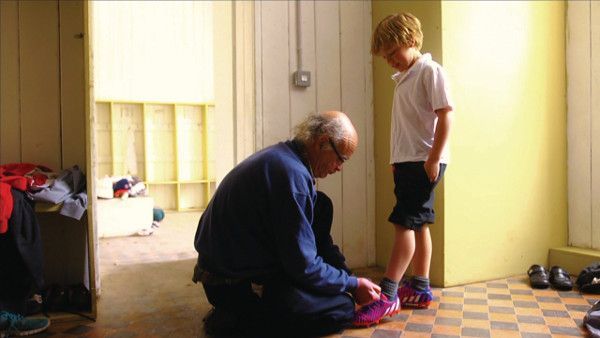Eye For Film >> Movies >> School Life (2016) Film Review
School Life
Reviewed by: Anne-Katrin Titze

School Life (In Loco Parentis), in quite miraculous ways, holds up a mirror to the world at large in the teens of the 21st century. As if sliding down a Möbius strip, we end up on the other side, where modern technology has not been allowed to take over children's minds.
We enter a private primary boarding school in Ireland, located in the 18th century ancestral estate of Headfort and never leave. Shot in vérité style, everyday occurrences - lessons, band practice, games in the forest, sports - unfold like a puzzling new universe for any incoming student.

The majestic building that houses the school is seen wrapped in the changing cloak of the seasons: autumnal fog blankets, sprinkles of rare Irish winter snow, flower eruptions that turn the grounds into a paradise of colours and smells (it must be so, the images surely don't lie). This century-spanning beauty is nicely juxtaposed visually with the somewhat messy, a little run down and child-friendly play and school and dorm rooms that are neither stuffy nor neat, neither elegant nor shabby.
"Who controls the past controls the future. Who controls the present controls the past," George Orwell logged in his 1984. This quote, as well as an image of the strolling, memorizing book people - Julie Christie and Oscar Werner among them - from François Truffaut's film adaptation of Ray Bradbury's science fiction novel Fahrenheit 451 came to my mind while watching Neasa Ní Chianáin and David Rane's remarkable, enchanted documentary that kidnaps us into a world-building realm of unlimited imagination.
How do mid-century futuristic fictions about oppressive regimes that feature book burnings and mind control relate to this progressive school, where reading is king and the children's happiness trumps all?
The filmmakers' gentle, subtle approach to the life of students and faculty - with a special spotlight on Amanda and John Leyden, a couple who taught at Headfort for decades - manages to chisel out portraits full of humour, sometimes warm, sometimes slightly absurd, that always welcome us to reflect on what we see and what exists, off screen, outside in screen land, where we live.
John and Amanda, proud dog owners, heavy smokers, extraordinary educators, form the core, as we are introduced to the Headmaster Dermot Dix (himself a former pupil of the Leydens) and a number of students who, with their assistance, each overcome a personal obstacle.
"Your education is up to you," is how Dermot welcomes the new students. They are in charge of their own lives, which doesn't mean that the 7 to 13-year-olds are without guidance, quite the opposite. By simply looking at the faces of the children, you genuinely want to hear what they have to say. It pays to take kids seriously - any respectable fairy tale will tell you that.
We meet Ted, a boy with dyslexia, who, encouraged by Amanda, discovers acting by way of Shakespearean ghostliness, and see new paths opening up. Eliza, smart and shy, comes out of her shell. Rarely has the sound of giddy chatter caused so much joy and a sense of victory. The camera of Ní Chianáin has the light touch of a welcomed guardian angel, not an intruder.
Florrie's experience modeling, at a very young age, brought her to the school as a much needed antidote to the arena of surface value. She flourishes in this environment where glamour seems no more than a joke. She and little Barbara are the school's drummers. These two, and John who teaches them a thing or two, make you understand what drums were invented for in the first place.
While some of the students battle homesickness, shyness, dyslexia, tone-deafness, or the challenge of having their shoelaces tied - you may feel a sudden pang of loss. Not for childhood per se, but for a time when screens did not block so thoroughly our view of each other.
Reviewed on: 03 Sep 2017














